Strawberries
Extension in the information age
Interesting article this weekend on the UC ANR homepage concerning extension in the information age.
http://ucanr.edu/?blogpost=15394&blogasset=52096
More on this at a later date, but this article covers neatly some of the thoughts I've had on how we at UCCE are using the web to extend and enhance our ability to serve.
It's a little wonkish, so I'll summarize the key takeaways here:
- Knowledge and information is produced and distributed by a network of people, not an individual. I can't any imagine any scientist being very successful in our industry working on his or her own these days, it's a given to bring representatives from all sorts of disciplines into a project, and then growers participate to keep things realistic and practical.
- Interesting note that partnerships can form across agricultural sectors, I would have to agree. Information flows pretty readily between our strawberry and caneberry industries, and I like to think that we have a decent connection with the lettuce and cool season vegetable industry.
- Last but not least, online information technologies can be innovative ways to connect and learn, but will never be a substitute for personal and in-person connections. In my opinion, an Advisor will not thrive simply by writing blogs and posting on social media. My experience is that these technologies enhance and enrich the work I am doing, but of course will never ever substitute for time in the field with the people we are here to serve.
Good article, it looks like the research is confirming what we are realizing in the field.
A Few Observations on Vinegar Flies in Strawberries
As any grower knows, vinegar flies, Drosophila spp., have been a major deal in strawberries the last few years. It seems the slightest delay in picking (especially in the fall) is met with an onslaught of vinegar flies followed by a huge loss of fruit.
I have the good fortune to be funded this year by the North American Strawberry Growers Association (NASGA) on a study looking at predaceous nematodes as a way of controlling vinegar flies. More on that at a later date, but having my research assistant Monise Sheehan and I spend some time looking closely at vinegar flies in strawberry brings up some observations that I would like to share here.
First of all, regular vinegar flies, as opposed to the spotted wing drosophila, Drosophila suzukii, do not oviposit in fruit, rather they oviposit on the surface. I am going to underline that this doesn't at all mean they won't damage the fruit, since it is only 24 hours each one spends in the egg stage before becoming an active larva fully capable of penetrating into the fruit.
It is interesting to see where the egg laying is taking place. It's uncommon to see eggs just deposited on a healthy fruit (Photo 2); it is rather in wounds (Photo 3) and cracks (Photo 4), bruises and any other kind of damage which softens and compromises the integrity of the fruit where the bulk of the eggs are found.
I think the take home message for strawberry growers and supporting professionals is to know how very fast the life cycle of vinegar flies goes and the big role that damage, be it wounds, cracking, bruising or general softness has in promoting their development.
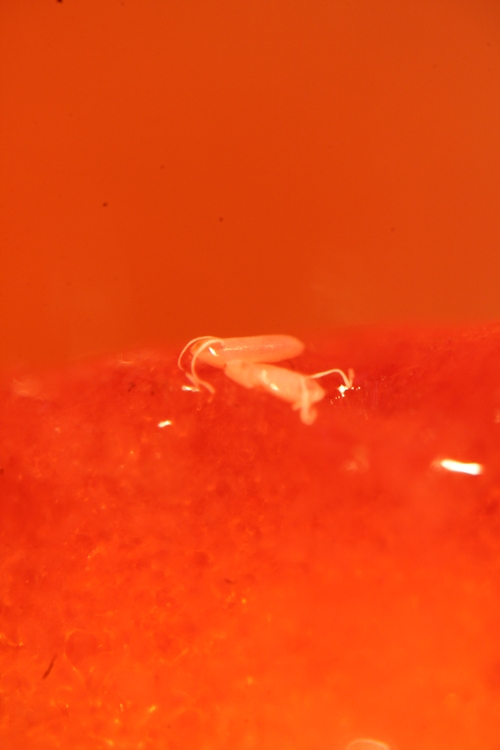
Photo 1: Vinegar fly eggs under the microscope. Long fibers are respiratory tubes.
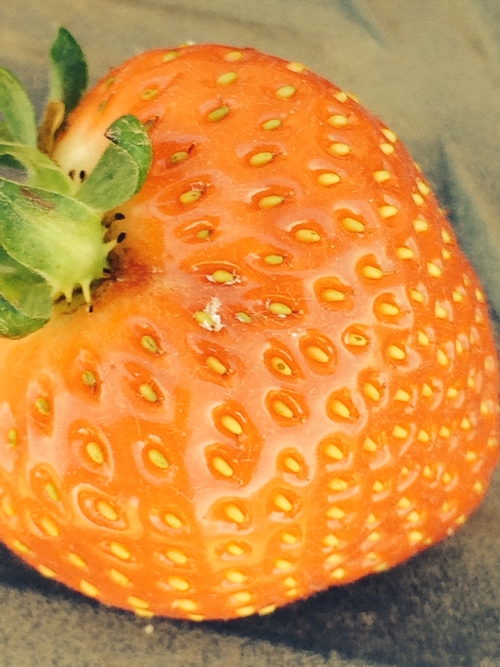
Photo 2: Mass of vinegar fly eggs on an ostensibly healthy fruit. The immaturity of this fruit is notable.
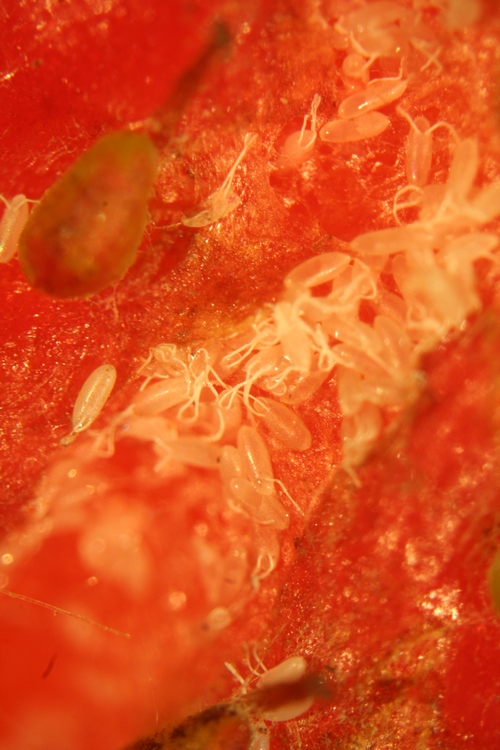
Photo 3: Mass of vinegar fly eggs in fruit wound, rendering it totally unmarketable.
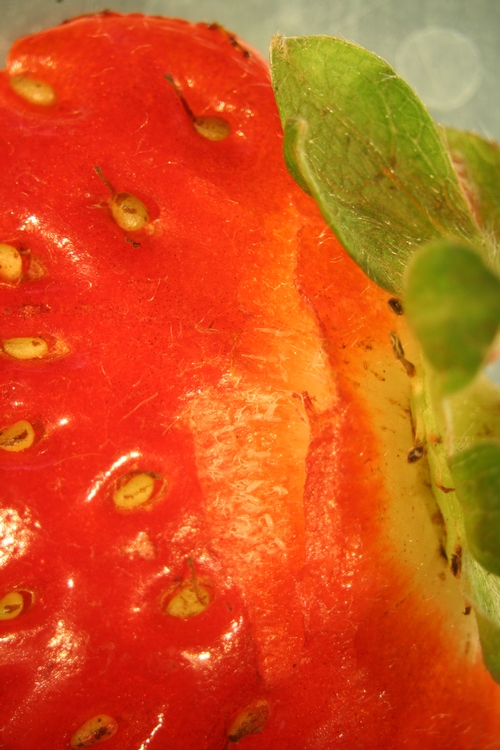
Photo 4: Vinegar fly eggs nicely lined up in crack under calyx. This fruit is lost.
Bagrada bug links
Bagrada bug is not necessarily a pest of strawberry or caneberry, but I get a lot of questions about it. It's good to be familiar with the basics at least.
http://www.ipm.ucdavis.edu/PMG/PESTNOTES/pn74166.html
And some blog posts by colleagues Joseph and Dara
//ucanr.edu/blogs/blogcore/postdetail.cfm?postnum=14915
//ucanr.edu/blogs/blogcore/postdetail.cfm?postnum=11632
http://westernfarmpress.com/vegetables/bagrada-bug-marching-north-california-crops
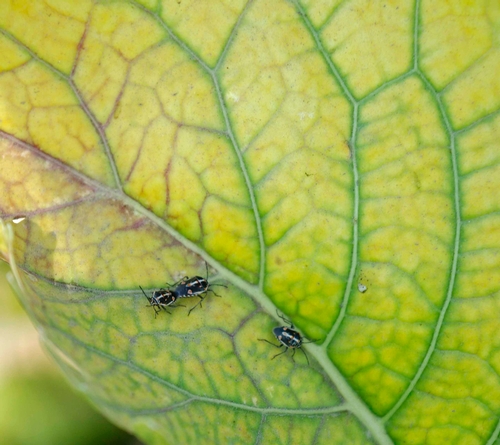
Bagrada bugs on horseradish
Warm Fall Temperatures, Plant Vigor and Mites in Strawberries
The link below is to a paper written by Doug Walsh, Frank Zalom, Doug Shaw and my predecessor Norman Welch. It succinctly makes the point that a warm fall following transplanting decreases plant vigor, encourages precocious bloom and can predispose strawberry plants to infestation by twospotted spider mites. Rain can reduce overwintering mite populations, but still warm fall temperatures will decrease plant vigor.
http://www.calstrawberry.com/research_library/97-04.pdf
With the understanding that this fall and winter has more than even odds of being an "El Niño" year (http://www.elnino.noaa.gov/), which could result in warmer temperatures and more precipitation, growers and agricultural people might want to be thinking about being a little bit longer than customary on cold conditioning of the day neutrals up here on the Central Coast.
I Have a Diagnosis of Macrophomina or Fusarium in My Strawberry Field – Now What Do I Do?
Accompanying the current spate of Macrophomina and Fusarium discoveries by the UCCE Diagnostic Laboratory in Salinas and by other pathologists, growers, farm managers, and PCAs are now faced with the question of what the next step should be.
Fumigation: The advice for growers and farm managers is to avoid bed fumigation at this juncture. Even beds fumigated by professional operators will have little reservoirs of surviving pathogens on the shoulders where the fumigant did not travel. Of great concern are pathogen populations surviving in the soil making up the untreated furrows. Growers who are not flat fumigating with methyl bromide + chloropicrin should consider using a high rate of chloropicrin under impermeable film. This likely will not be as good a treatment as the mix of methyl bromide + chloropicrin used in the past, but it is the next best soil treatment solution.
Reducing stress to the plants: The diseases caused by both Macrophomina and Fusarium develop earlier, more rapidly, and more severely if plants are stressed. Strawberries that are under-chilled or subject to irrigation deficits, fertility shortfalls, and/or pest issues (such as mites) can succumb fairly rapidly, while those perfectly managed can withstand disease for a longer time. Growers wanting to reduce their diseases losses from here on out will need to play a tight defensive game and address plant stress factors in a timely manner.
Not disturbing the existing bed: The in-field spread of both Macrophomina and Fusarium is mainly accomplished by tillage and other procedures that move soil around. Because neither pathogen makes airborne spores (such as those made by powdery mildew and gray mold pathogens) or swimming zoospores found in soil water (produced by Phytophthora), the spread of inoculum is only by physical movement of the soil. Presumably, beds remaining intact and in place, as they would be for second year strawberries or other system of minimal tillage, will keep the pathogen from being spread to non-infested parts of the field.
This situation has been observed locally. In 2013, a strawberry field had significant Macrophomina outbreaks in certain parts of the field. Held over for a second year, the dead areas were replanted and again developed disease in those sections; however, second year plants that were healthy in 2013 were mostly healthy in 2014. While growing second year strawberries is not being recommended, this type of situation demonstrates the key role of soil movement in disease epidemiology.
Sanitation: Sanitation is critical for limiting the spread of Macrophomina and Fusarium. Tractors, tillage equipment, and irrigation pipes moving from infested fields should be cleaned. Remember too that a strawberry field that had significant dieback two years ago and is now planted to lettuce or another crop, likely still has plenty of Fusarium or Macrophomina around. It is a good practice for all of us to pay attention to where we have been and clean up if you are coming out of an infested field.
Having the Right Attitude and Accept the Changing Reality: In this environment of new diseases and reduced to no availability of good fumigants, those able to keep open minds and adopt new practices stand the best chance to weather the storm from these new pathogens. Growers and agricultural professionals of all stripes MUST adapt to this new era. Go to meetings, keep up to date on the latest research, talk with reputable professionals and be ready to make the changes necessary to keep your crop the most productive it can possibly be.
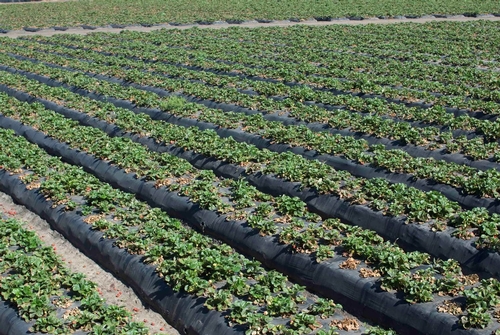
Photo progression- Field with Macrophomina June 21. Photo by Steven Koike, UCCE.
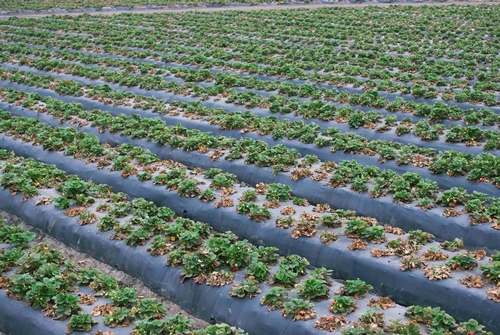
Photo progression - same field as above with Macrophomina- July 5. Photo by Steven Koike, UCCE.
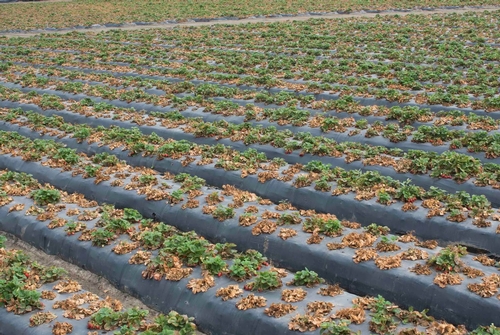
Photo progression - Same field as above with Macrophomina July 26. Photo by Steven Koike, UCCE.

